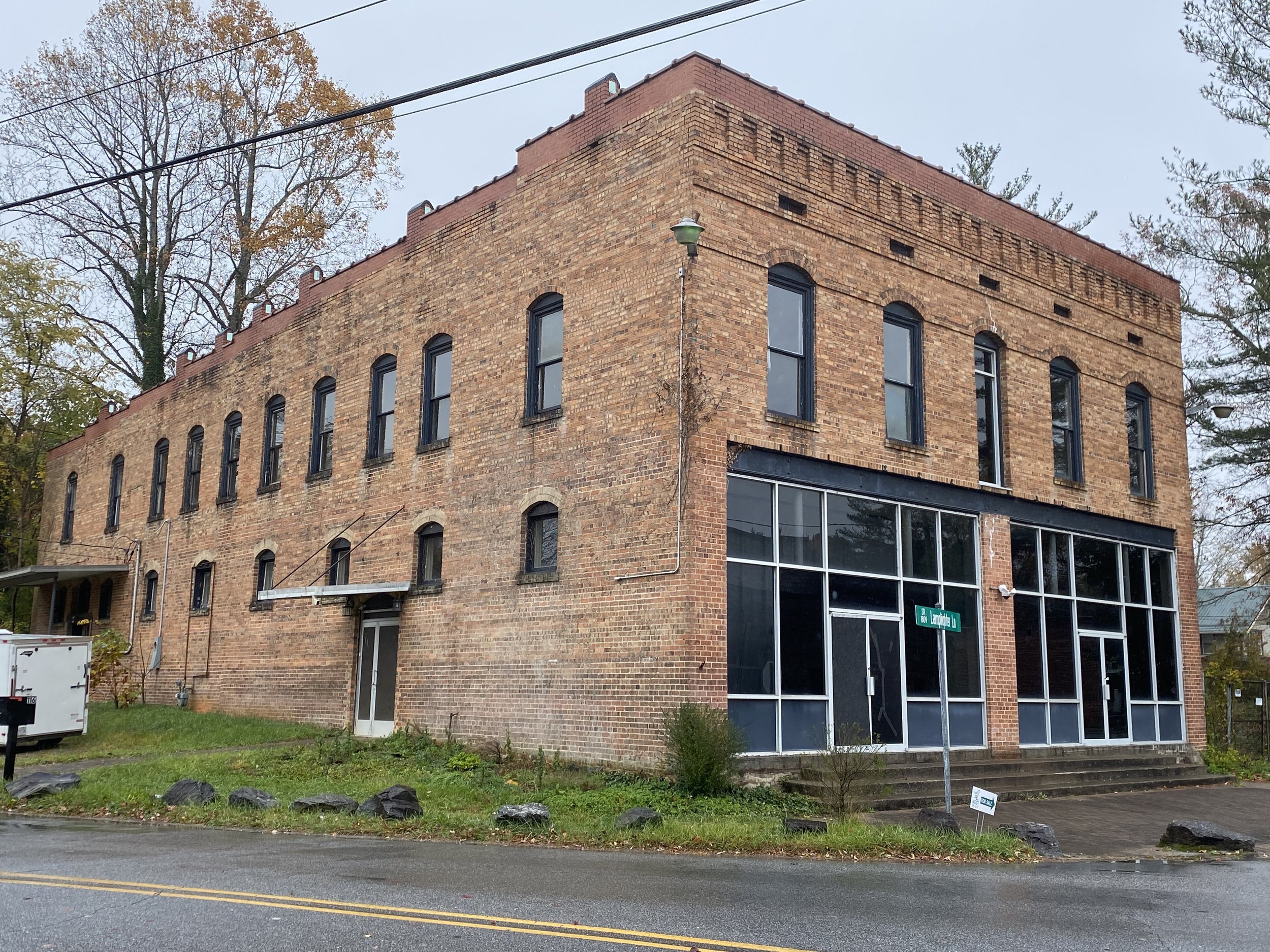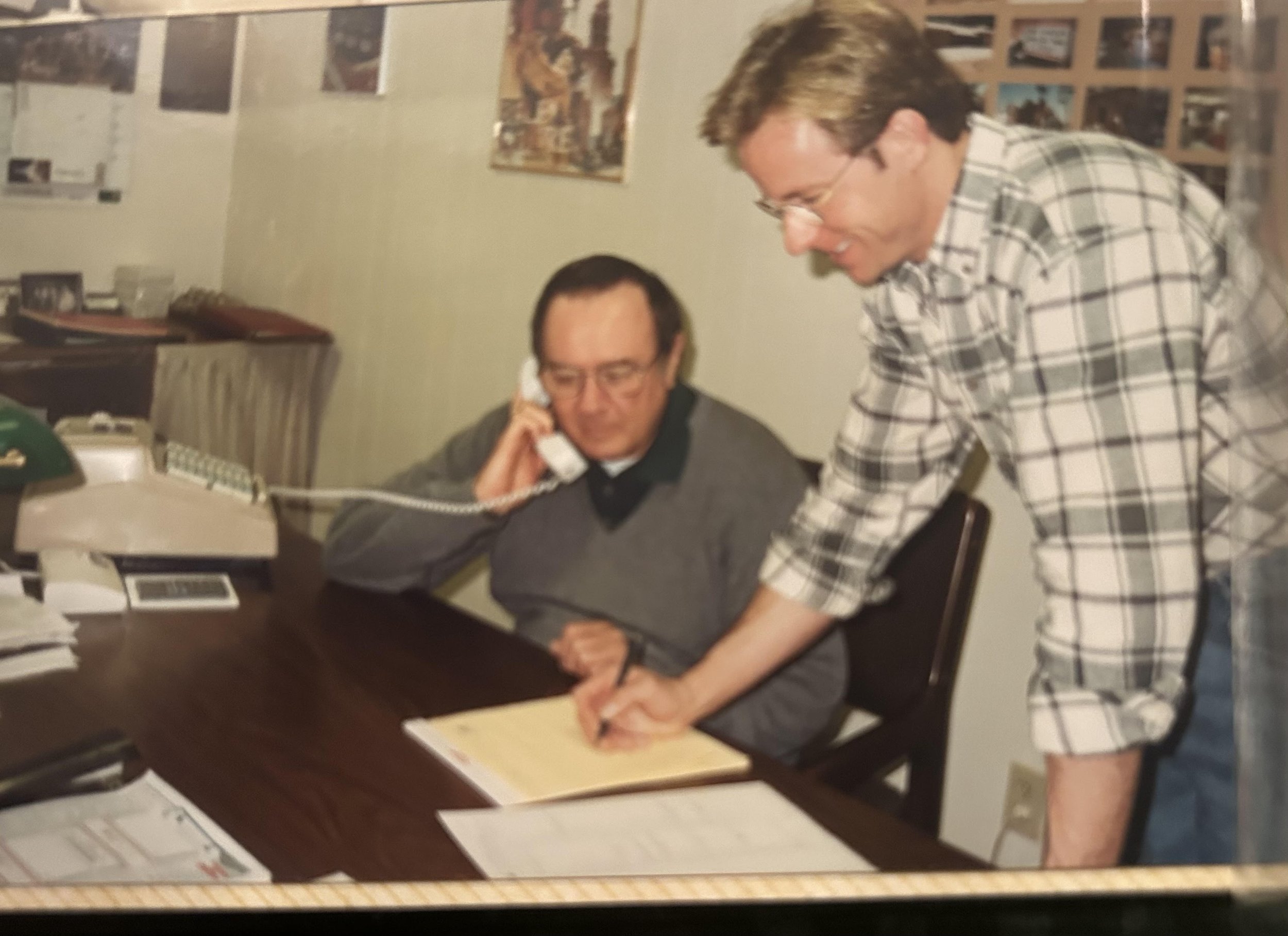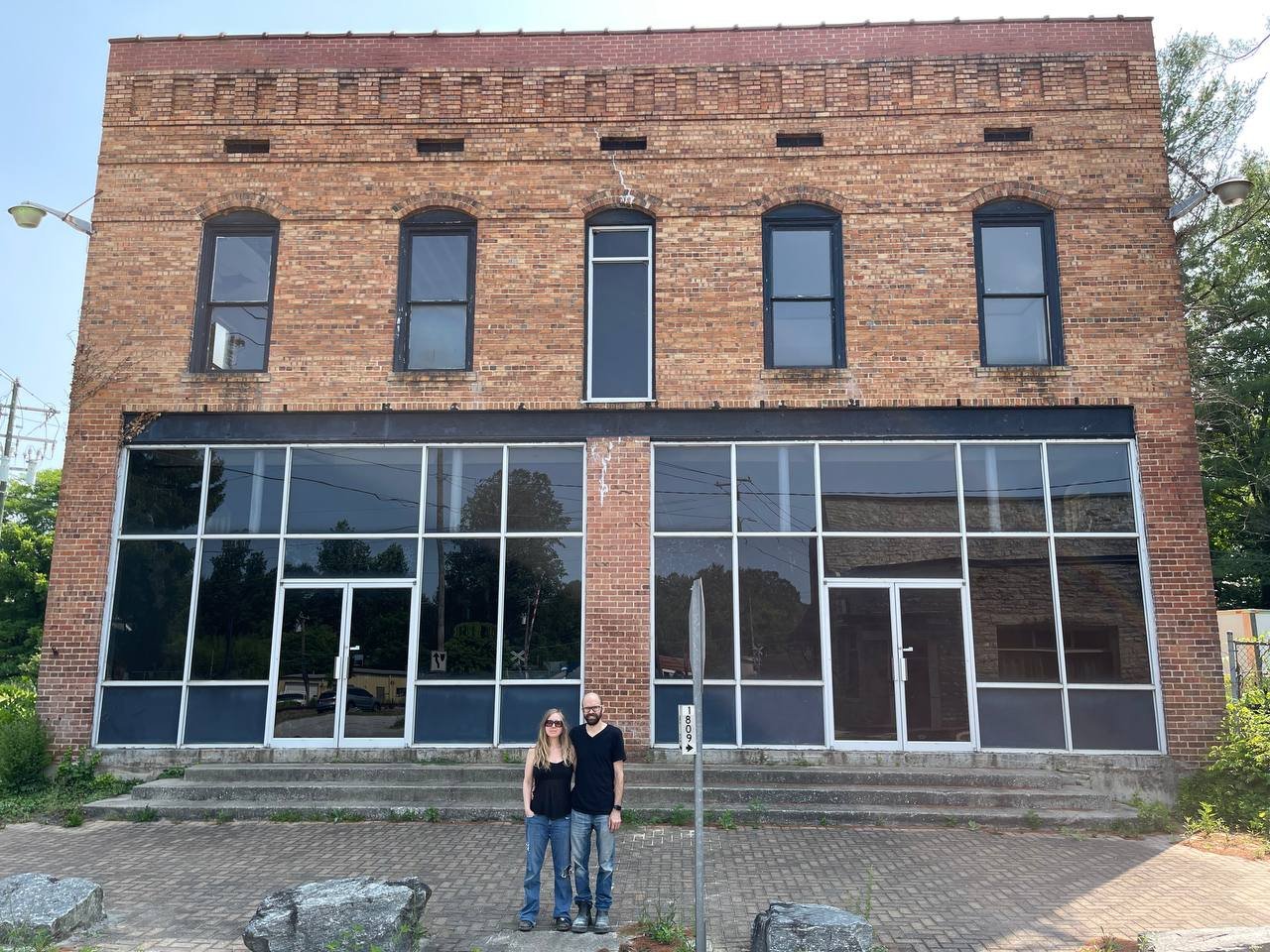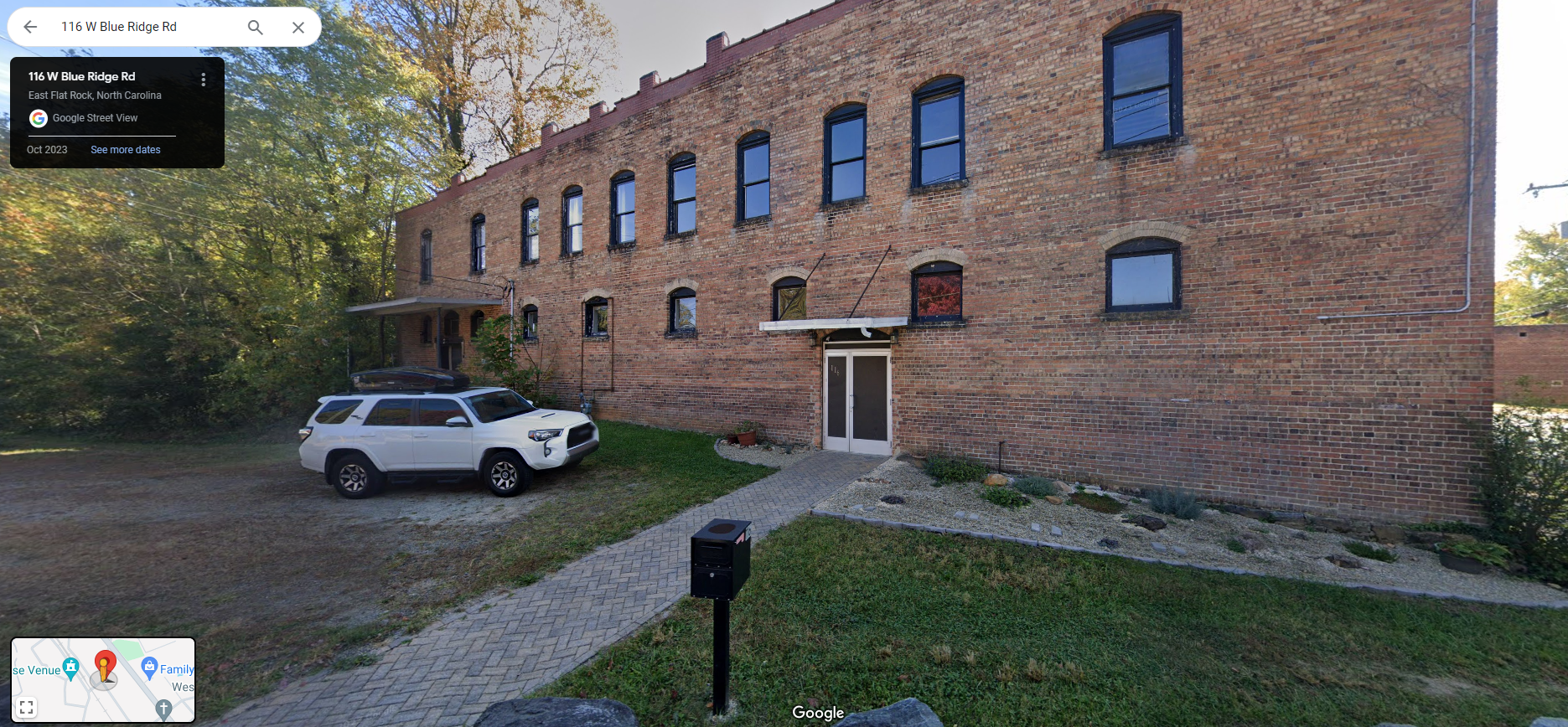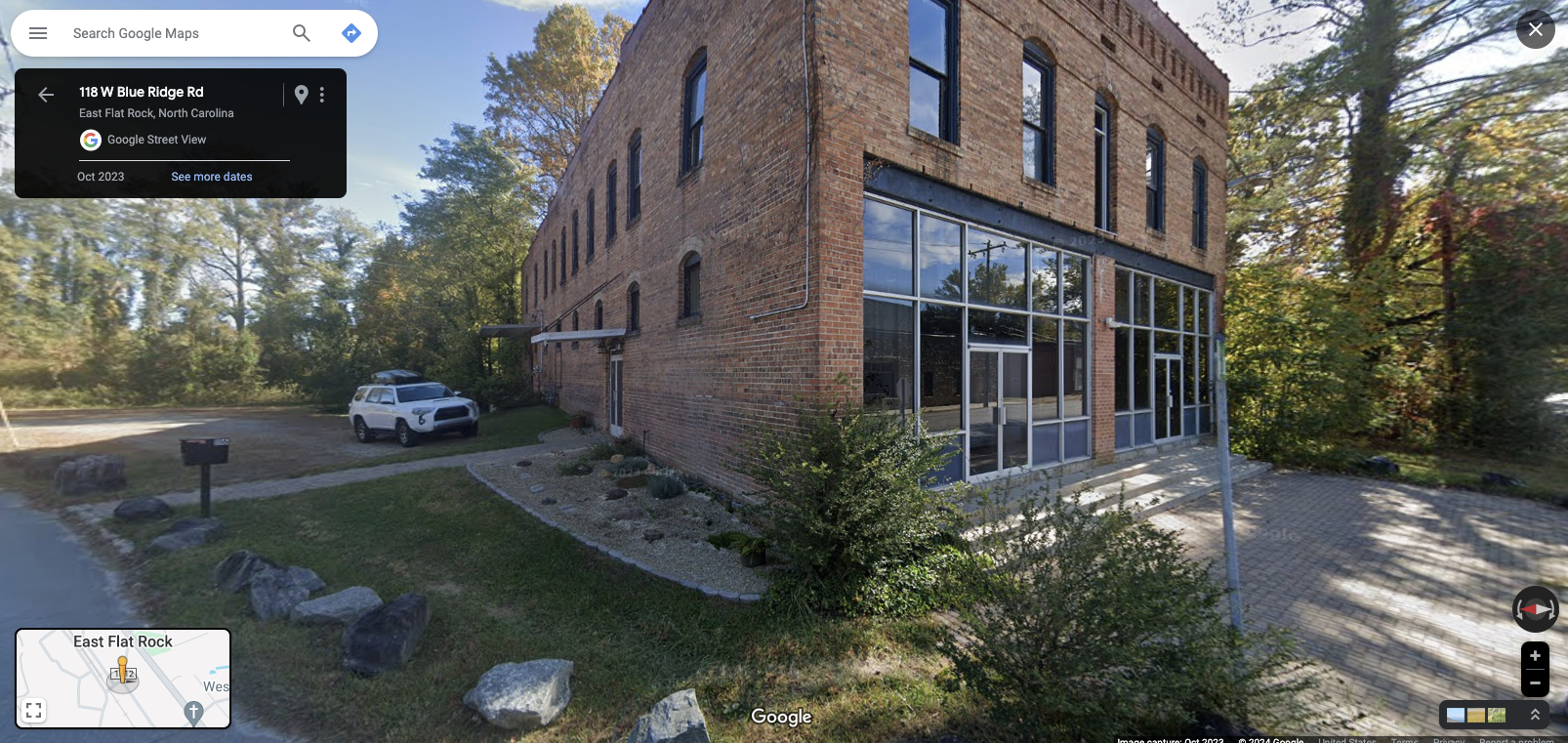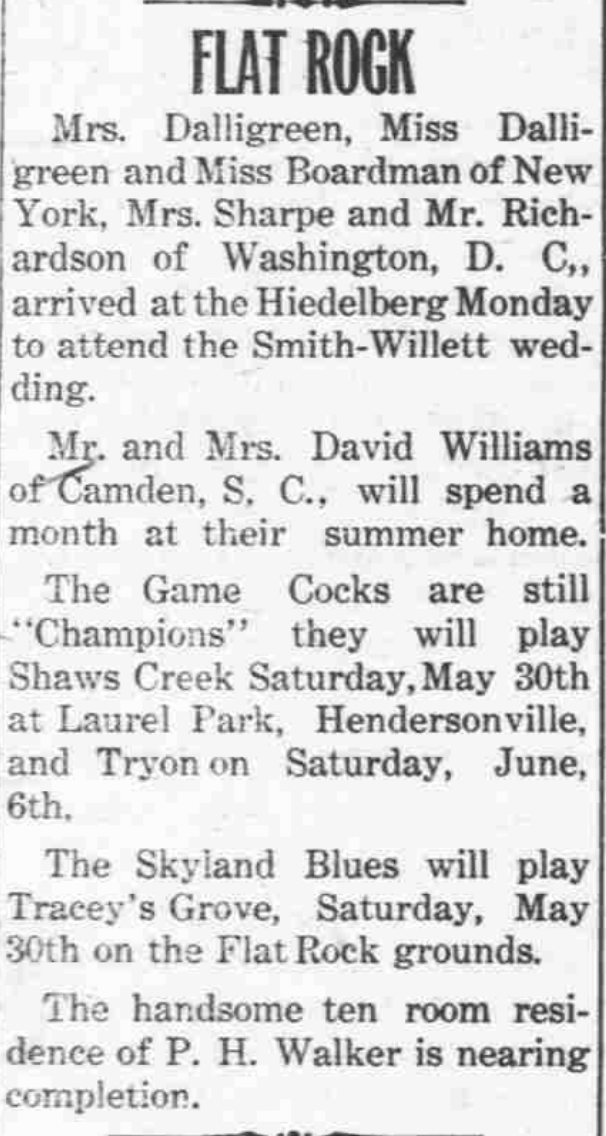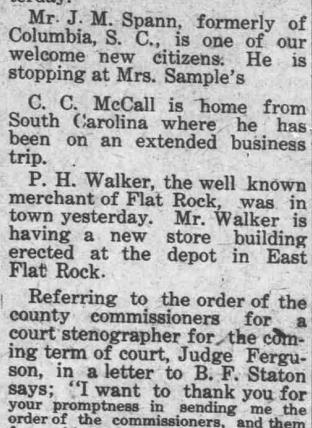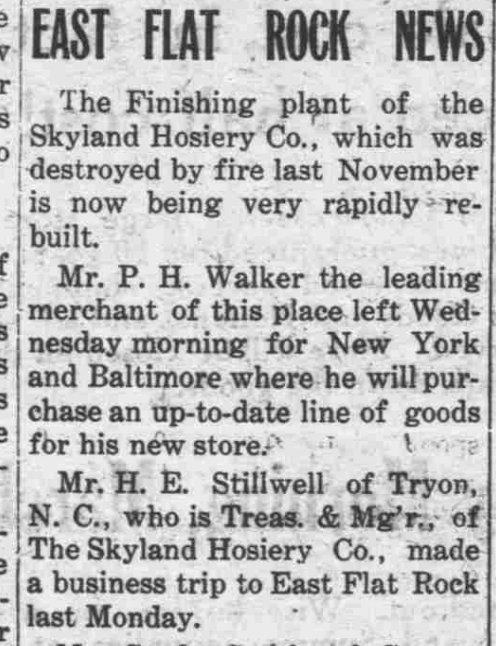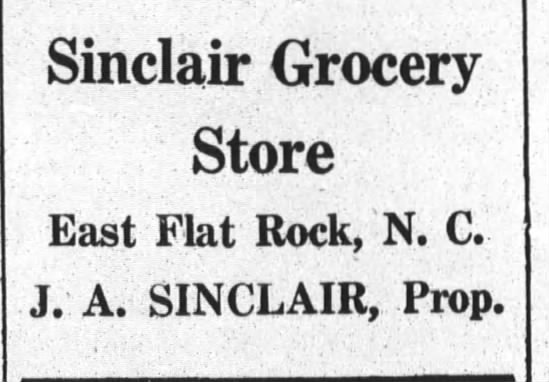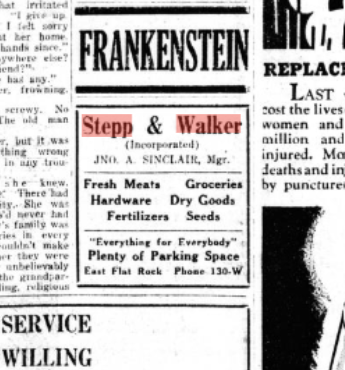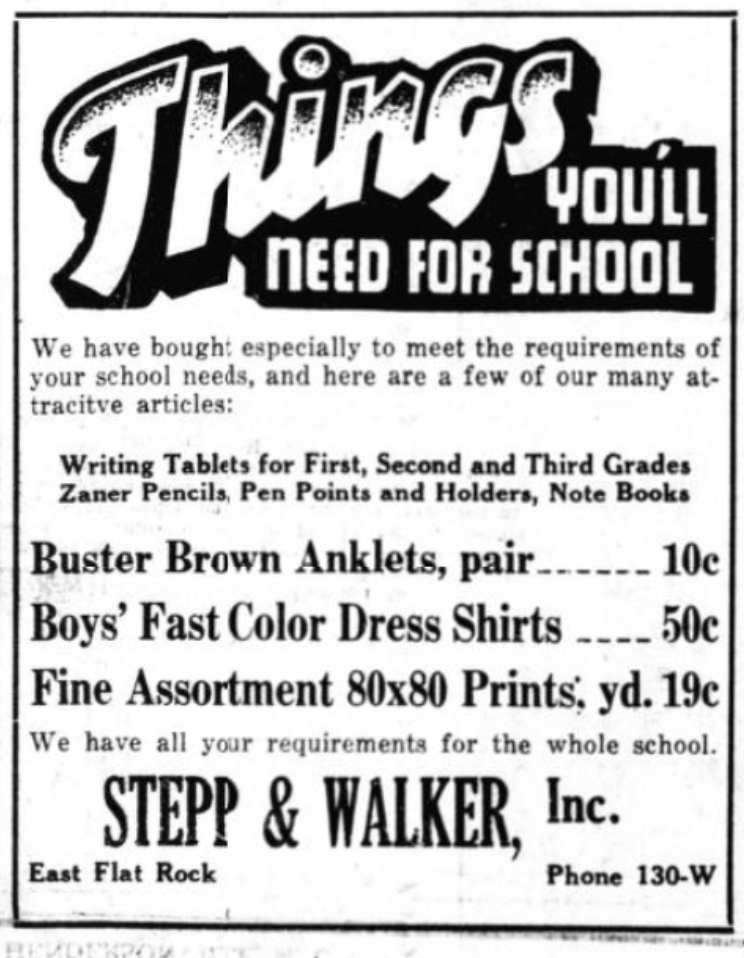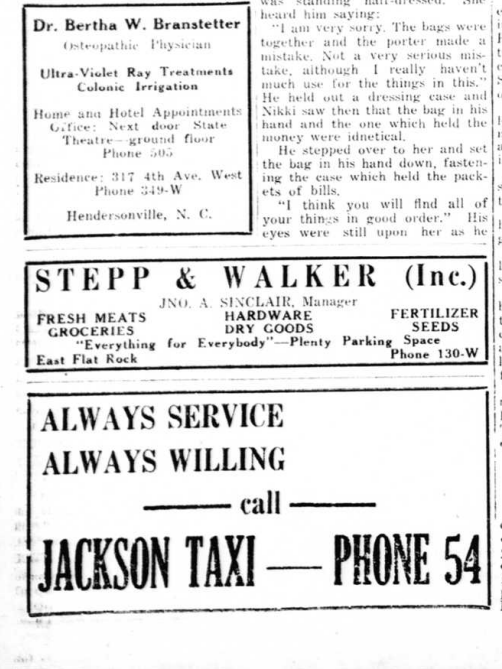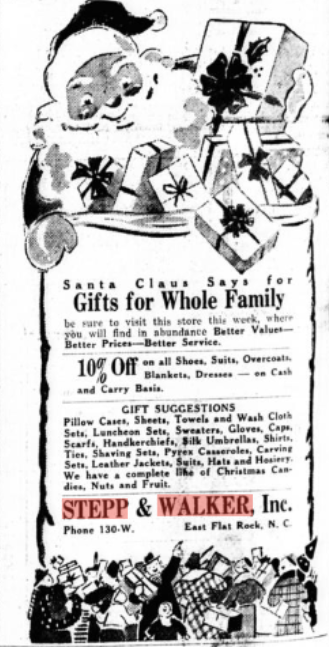New Life for an Old Building
/Stepp Walker Building, East Flat Rock
New Life for an Old Building
The Stepp and Walker Store
East Flat Rock
In the heart of East Flat Rock stands a two-story brick building that has been at the center of the small community’s business and civic life for over 115 years. Referred to by many long-time residents of East Flat Rock as the Stepp Walker building, the large structure with a long history had fallen into disrepair in recent years. For much of the previous decade, local residents and passersby on West Blue Ridge wondered what the fate of the historic building would ultimately be.
Fortunately for the East Flat Rock landmark, an enterprising couple living in California showed up in the midst of a pandemic and saw incredible potential in the 10,000 sq. ft. structure – notwithstanding the many broken windows, leaking roof, crumbling plaster, remains of small dead animals, and the strong smell of mold, mildew, and general decay. The venerable old edifice was in rough shape, but the couple who’d driven 2,200 miles to see it saw good bones and the possibility of finally realizing their long-held dream.
Today, Stepp Walker has new owners, a new lease on life, and is once again emerging as a centerpiece of life in East Flat Rock. This is the story of a remarkable old building that has been given a new lease on life.
Note:
Most of the following history of the Stepp Walker building contained in this article was compiled through research by local historian and East Flat Rock native, Jennie Jones Giles. Assistance and research was also provided by Rebecca Foster and Richard Freudenberger. Links to Jennie’s full account of the timeline for the building, its owners, and the stores that occupied the space follow the article. The author is grateful for their assistance.
This installment is Part One of the story and deals with the history of the building up to 2020. Part Two will be published next week and tells the story of the couple who saved the Stepp Walker building. -BH
---
Train Depot at East Flat Rock
The pre-history of the Stepp Walker building is tied to a young couple that met in Henderson County and embarked on a life together that would have significant implications for the growth and development of the area we now know as East Flat Rock.
Perry H. Walker (1859-1920) was born in the Butler community of Greenville County, South Carolina. Later accounts of his life stated that he was employed as a salesman by merchants in his native county. He was described as “one of the best salesmen in the upper part of South Carolina.”
In 1886, Walker married Gertrude A. Hart of Flat Rock and the couple started their life together in Henderson County. Gertrude was the daughter of a well-known Flat Rock merchant by the name of Andrew Jackson Hart. Andrew Hart had opened a store in Flat Rock that stood in the area near the present-day Rutledge Drive intersection with Greenville Highway. The census of 1880 lists Hart’s occupation as “dry goods merchant.”
French Broad Hustler, May 8, 1913
Perry Walker, clearly possessing a knack for business, also became a merchant and his first store was located in Flat Rock. By 1887, Walker and his wife began purchasing land in both Flat Rock and the area that eventually became known as East Flat Rock. Perhaps he anticipated the economic effect of the trains that began servicing Flat Rock (via East Flat Rock) in 1887. The original depot in East Flat Rock (still referred to as Flat Rock in those days) was a simple log cabin. In 1889, a true train depot was constructed on the site and the winding road that connected East Flat Rock and Flat Rock was referred to as “the depot road” – now West Blue Ridge.
Walker’s land purchases in East Flat Rock were mostly from the local Appalachian mountain people. In 1898, the couple purchased land just east of the train depot that would become the site of both the Stepp Walker building and their new home in East Flat Rock. All told, Perry and Gertrude Walker purchased nearly 300 acres in the area and sold lots to local residents who moved from outlying areas to be part of the new and growing community.
French Broad Hustler, May 8, 1913
By 1904, Walker began building houses in East Flat Rock and in 1907 the Walkers sold 21.5 acres of land adjacent to the railroad line and just north of the new depot to Tryon Hosiery Co. In 1908, Skyland Hosiery Mill was operating and helped accelerate the growth of East Flat Rock. A new post office was built in 1908 and in that same year, the Walker’s finished their new home on Lamplighter Lane. That home was directly adjacent to the two-story brick building that was also built ca 1908 and would come to be known as the Stepp Walker building.
--
Perry Walker’s Store
A March 3, 1910 story in the French Broad Hustler newspaper verifies that Perry Walker was operating a general store out of the new building.
“P. H. Walker the leading merchant of this place left Wednesday morning for New York and Baltimore where he will purchase an up-to-date line of goods for his new store”
Another article written in 1917 states that Perry H. Walker owned the store and building in East Flat Rock: “largest store in the county under one roof” and the article states the store sold general merchandise.
A different newspaper article in the same year states, “11 years ago ground was broken for the first store in East Flat Rock.” The story also referred to Walker as “the father of East Flat Rock.”
It was reported that Walker had previously purchased nearly 300 acres near the railroad and another 21 acres of the old Judge Mitchell King tract. Walker helped spur the growth of East Flat Rock when “lots were sold at reasonable prices.” The arrival of the Skyland Hosiery Mill ca 1907 provided important infrastructure in the form of electricity and water lines. The land for the mill had also been purchased from Walker.
Western NOrth Carolina Times, Nov 19, 2020
Sadly, Perry H. Walker’s business career was cut short when he died in 1920 at age 61. His obituary in the Western North Carolina Times was front page news and states that he had operated his East Flat Business until a “comparatively recent date when his health failed him.” It summarized his life with:
“The deceased was a good businessman, who was well-liked and highly respected by those who knew him, and his passing is deeply regretted by a wide circle of friends and relatives.” Western North Carolina Times, Friday, November 19, 2020
Walker was survived by his wife Gertrude but the couple had no children. The new widow was left as the sole owner of the store building, adjacent property, and the house on Lamplighter Lane.
After Perry Walker
Following Walker’s death, Burckmyer and Co. assumed the space and was managed by William M. Gill by 1922. A newspaper report from that year states that the store sold groceries, dry goods, notions, hardware, produce, feeds, flour, wood, and crossties. The building was still owned by Gertrude Walker and Burckmyer leased the space from her.
By 1925, the store (not the building) had a new set of owners – Marion Lee Walker - Perry Walker’s nephew - and Joseph Hamilton Stepp. J.H. Stepp owned a large farm in the Dana community and operated a store in Dana called J.H. Stepp Store. He was a business partner in the East Flat Rock venture and supplied the store with produce. Management of the store was left to Marion Walker and John A. Sinclair. It was at this time that the store became known as the Stepp and Walker Store. The building had acquired an appellation that was to stick for the next century.
In 1930, Gertrude Hart Walker died and left the building to her nieces and nephew: Nellie Hart, Edith Hart, and Daniel Hart, who were the children of her brother Philo. The store continued as Stepp and Walker with the same management team of Walker, Stepp, and Sinclair. A 1934 article states that, by that time, Marion Walker had owned one-half of the Stepp and Walker store for several years and that he was, by then, a former mayor of East Flat Rock. A 1936 Christmas ad lists the store as selling bicycles, tricycles, toys, Christmas fruits and nuts, candies, farm supplies, dresses, shoes, hats and shirts.
Times-News Hendersonville, FEb 9. 1937
In 1937, Marion Walker sold his share to John A. Sinclair and left to open the Walker Hardware Store located on First Avenue in downtown Hendersonville. His son later told reporters that Walker got into hardware so that he would no longer have to worry about his food inventory spoiling on the shelves. In the late1940s, John Sinclair and his wife opened Sinclair Men’s Store at 333 Main Street in Hendersonville. The next recorded business occupant was Fred Pressley Grocery.
Fred Pressley Grocery Store; Ca 1950 – 1965
Following WW II, Fred Warren Pressley returned home to Henderson County having completed his tour of duty with the US Army. His daughter, Elizabeth Pressley Hill recalls that he had experience as a young man working for a grocery store (possibly an A & P) located across from the old Courthouse in Hendersonville.
Fred Pressley
Fred Warren built upon that experience and opened Fred Pressley Grocery in the Stepp Walker Building in the early 1950s. Although primarily a grocery store on the left side of the building (as you face it from Lamplighter Lane), the right side of the building was used by Pressley to sell hardware supplies. Elizabeth recalls bins of nails and screws and a paint-shaking machine. Pressley also sold appliances for some portion of his time in the building.
In the early 1950s, the building was still owned by Edith and Nellie Hart. They leased the lower half to Pressley for his business operations and the sisters lived upstairs. There were outside stairs on the south side of the building which the sisters would use to get to their apartment. Although very young at the time, Elizabeth Hill remembers Edith Hart would step into the store from time to time. “She was a very warm, friendly, lovable lady,” recalls Elizabeth.
Elizabeth recalls accompanying her father to the store on Saturdays occasionally and has fond memories of time spent with her daddy there. “Being there with Daddy was fun. A lot of the local people would come in and the store was an important part of the community,” says Elizabeth. It was also a place for locals to gather. “Some of the older men of the community would sit on the steps out front and visit with each other.”
Just down the street was Hill’s Grocery owned by Charles Hill and Elizabeth recalls that Mr. Hill and her father were friendly competitors. “If Daddy was out of something somebody needed, then he might run over to Hill’s to get it. And Charles Hill did the same thing. It was just a good community to be in.” Eventually, Elizabeth Pressley would even end up marrying a younger cousin of Charles Hill.
For a short period of time, Fred Pressley shared some of his store space with Hunter Spearman who had a meat counter at the back of the store. Elizabeth recalls that Spearman was in the Stepp Walker Building for only a couple of years before finding his own location for the market. The Spearman family also owned a furniture store in East Flat Rock.
Health concerns prompted Fred Pressley to sell the business in 1965 or 1966. Before he closed his business, however, he had sublet the hardware side of his business to Warren G. Cairnes who used the space to operate a feed and seed and agricultural supply business out of the space called C&C Supply. When Fred Pressley left, Cairnes rented the entire lower level of the building from the Hart sisters. In 1971, Cairnes purchased the building from Edith Hart.
Although the lower half of Stepp Walker was dedicated to commercial enterprise, the upper level was fitted as a residential space. In 1919, Nellie Hart and Edith Hart were well-known spinster schoolteachers at East Flat Rock High School who would ultimately teach generations of East Flat Rock children through the1940s, with Miss Edith Hart teaching into the 1950s. It is reported that the two sisters lived in an apartment above the store.
The upper level still has six large rooms which were reportedly rented to single women – perhaps local schoolteachers. An outside staircase was constructed on the south side of the building to allow the renters to access their rooms without having to enter the store on the first floor.
Sold to the Cairnes Family
Edith Hart and Nellie Hart owned the building for 41 years. After Nellie died in 1969, Edith (and possibly her brother Daniel) were left to decide what to do with their uncle’s old building. In 1971, it was sold to Warren G. Cairnes and his wife, Mary Rebecca Fisher Cairnes. Following the purchase, Warren and his brother, Fleet, operated a store out of the building called C&C Supply that sold feed and agricultural supplies. Later, Warren would start a very successful company called Forge Mountain Country Store that featured homemade jams, jellies, relishes, gifts and more sold to other retail outlets, including area Ingles grocery stores.
By the early 1980s, Warren Cairnes's health was starting to decline and he sold his business.
The Kirkpatricks and Forge Mountain Foods
Warren Cairnes operated C&C Supply in the Stepp Walker Building from the mid-1960s until the late 1970s. During those years, he supplemented his feed and agricultural business with a wholesale food operation called Forge Mountain Country Store that feature homemade jams, jellies, relishes, gifts, and more that were sold to retail outlets and are Ingles grocery stores.
Forge Mountain Foods delivery truck
Perhaps due to health concerns, Cairnes sold his C&C business to Doris and Wayne Cole and leased them space in the Stepp Walker Building to continue operating the business. The Coles owned the business for just a few years before deciding to sell it to Bill Kirkpatrick in 1983, The Coles may be a familiar family name for local readers as the owners of the iconic McFarlan’s Bakery in downtown Hendersonville from 1952 until 1974. Their son, Mike, ultimately bought back the business in 1994 and ran It with his wife Kathy until 2023.
In the early 1980s, Bill Kirkpatrick was living with his family at Lake Summit and had retired from his successful career in architectural and engineering marketing. Looking for a business to purchase, Kirkpatrick learned that the Coles were ready to part with C&C Supply. The business fit the profile he was seeking and in 1983, Bill Kirkpatrick became the third owner of C&C Supply.
Bill’s son, Jim Kirkpatrick, was a student at Wake Forest at the time and recalls working in his father’s store during summers. “I was there slinging fertilizer and the loading pallets of jelly. We had delivery trucks traveling all over western North Carolina.” Initially, the business continued to sell agricultural products, but Bill Kirkpatrick soon realized that Forge Mountain Foods was the most lucrative part of the business. “Dad was glad to get out of the seed and feed business because it was heavy stuff to move around and low-profit margin,” Jim remembers. “He got really focused on the food business.” Over time, Forge Mountain Foods grew and even developed a very successful mail-order catalog business.
As much as he enjoyed the business, Bill Kirkpatrick was no fan of the aging brick building. “Dad never liked that building,” Jim recalls with a laugh. “There was just one overhead gas blower for heat and we had kerosene heaters scattered around the building in the winter and then there was no AC in the summers.” When Cairnes offered to sell him the building, Bill declined.
Bill (left) and Jim Kirkpatrick
As business grew, Kirkpatrick realized that he would need to find a new location. As a result, he purchased land at 1215 Greenville Hwy and built the new custom building in 1986 and 1987. Business continued to grow. “Forge Mountain Foods started out selling jams and jellies from local farm ladies,” Jim explains. In its heyday, there was a small plant in Dana managed by Linda Justice that was producing up to 12,000 jars a day. “Linda was a real entrepreneur, and she was great with food and figuring out products. We grew it into a nice little business.” The Kirkpatricks sold Forge Mountain Foods in 2004, but the new owner was not able to continue the company’s success and it was soon out of business.
Garden Gate Nursery
1994 Sketch of Garden Gate Nursery
Mickey Lively subsequently rented the building for his Garden Gate Nursery business selling fertilizer, seed, lime, and gardening supplies. Garden Gate also provided landscaping services and had a nursery on the property outside that stretched from Lamplighter Lane to Spartanburg Hwy. Lively was hoping at the end of the lease agreement he would be able to purchase the building, but Cairnes was not prepared to sell and Lively moved his business to property he already owned in the early 1990s.
In 1995, Back Home Magazine moved into the building and rented the space for roughly a decade. Back Home was started by a group of individuals who had been employed by Mother Earth News which had an office and store in Hendersonville during the 1970s and 1980s. When Mother Earth left Hendersonville in the late 1980s, the former employees preferred to stay in Henderson County and started their own competing magazine. The new magazine started in 1990 with offices on 3rd Street. Richard Freudenberger, who managed Back Home, was a neighbor of Warren Cairnes and when the magazine needed more room for its growing operation, Warren offered his building in East Flat Rock. Back Home would stay in the building until 2005/6.
During the tenancy of Back Home, Warren Cairnes died in 1999 and Mary Rebecca Fisher Cairnes became owner of the property. When she died in 2008, the property was deeded to her daughter Rebecca.
BAck Home Magazine
In the years after 2006, the building was used briefly by a local Moose Lodge which put in a commercial kitchen, built a bar, and started to construct offices before ultimately abandoning their plans to upfit the space as their new lodge. Following that, it seems the building remained empty – possibly for as long as 10 years. At some point during that time, the back door to the upper level was kicked in and there was evidence of unauthorized use of the space as the building slowly began to deteriorate.
Then, in early 2020 in the midst of the pandemic, Melanie and Daniel Hopkins were living in a small apartment in California but dreaming of finding a brick building they could rehab and convert into a loft living arrangement with room for an art studio, workshop, and perhaps a new business of their own.
While browsing the internet one evening, a listing for 116 West Blue Ridge Road in East Flat Rock, NC popped up on Daniel’s computer screen. He read the description and flipped through the images. He showed the listing to Melanie. As events unfolded, that was the moment when an old building in East Flat Rock was given a new lease on life and a new chapter in the long history of the Stepp Walker building began to be written.
Next week: Melanie and Daniel's story.
----
About Jennie Jones Giles
Jennifer "Jennie" Jones Giles is a descendant of at least 30 of the earliest settlers in Henderson and Polk Counties. She has researched the history of Henderson County and the genealogy of families in the county for more than 30 years. As a journalist at the Hendersonville Times-News, she received the New York Times Chairman's Award, Associated Press Awards, N.C. Press Association Awards and N.C. Society of Historians Awards.
She taught continuing education classes on the History and Heritage of Henderson County at Blue Ridge Community College for more than 10 years, developing and conducting research for the website hendersonheritage.com for use with the classes. She taught social studies in Polk County and was the first director of the Henderson County Heritage Museum. She serves on the Henderson County Cemetery Advisory Committee, preserving the historic cemeteries in the county.
Link to her research here.


